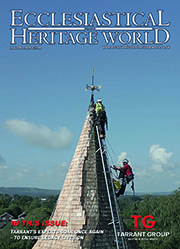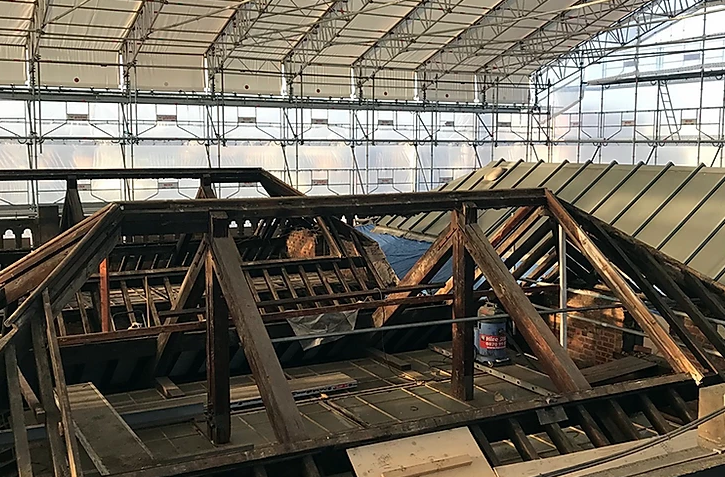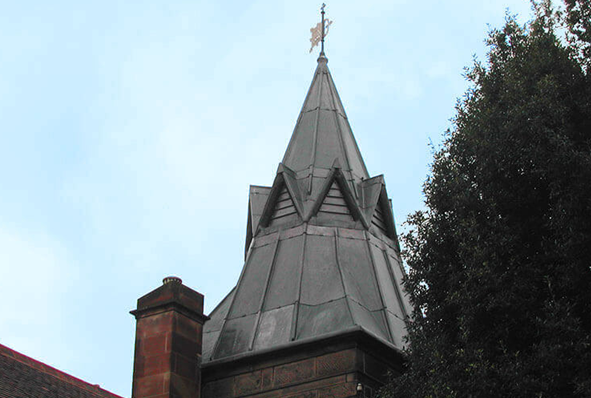Heritage Roofing
Heritage roofing - maintaining our iconic buildings
The UK is home to some of the most iconic buildings in the world, from stunning churches and cathedrals to historic stately homes. Each and every one of these remarkable feats of architecture requires regular maintenance to ensure they remain in the very best condition, allowing them to be enjoyed for generations.
Lightning Protection
When lightning strikes are you protected against this act of God?
The issue of lightning protection in churches is one that has exercised this publication for many years. In this four-part series of spotlights on the issue we will be revisiting various aspects of the subject, beginning with an overview of current thinking.
Traditional Lime
Lime: it’s better for buildings – and for the environment
It is now fairly well known that cement is not good for old buildings and that lime mortar should be used. But why? What are the advantages and what are the disadvantages? In order to begin to answer those questions it is necessary to understand the nature of traditional building, the process by which buildings used to be built, and how it differs from modern construction, the process by which we build today.
Audio Visual
Audio visual equipment in church buildings
This guidance is issued by the Church Buildings Council under section 55(1)(d) of the Dioceses, Mission and Pastoral Measure 2007. As it is statutory guidance, it must be considered with great care. The standards of good practice set out in the guidance should not be departed from unless the departure is justified by reasons that are spelled out clearly, logically and convincingly.
Read More...
CRE Events
Churches are coming under starter’s orders for CRE 25
Churches across the nation are beginning to make preparations for their visit to Christian Resources Exhibition’s CRE 25.
Insurance
You need to ensure that reasonable precautions are in place at your church to keep it safe for those who use it. To do this, you need to think about what might cause harm to people.
You will then need to decide if the precautions already in place are adequate. If they are not, you may need to identify further action to prevent any danger. When done formally, this is known as a risk assessment.
LPOW Grants
£23 million government package to support restoration of thousands of listed places of worship
Heritage Minister Sir Chris Bryant has announced that the Listed Places of Worship Grant Scheme will be extended into the next financial year, providing £23 million so that thousands of historical buildings, including churches, synagogues, mosques and temples, can carry out restoration work.
Lead Roofing
Lead is one of the oldest materials in the roofing industry and is still commonly used throughout the world today.
Lead roofing is a traditional roofing method which has been used in the industry for hundreds of years, and is therefore proven to be extremely reliable. Lead roofing, and sand-cast lead, in particular is ideal for old buildings such as churches or historical renovations, whereas milled lead roofing is a mass-produced alternative, used for precision and accuracy in homes and commercial buildings alike.
Home
A new organ for St Matthias & St George
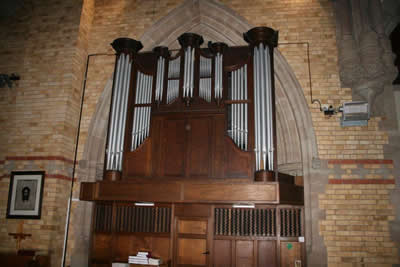 As I write this we are working on site to install the new organ for St Matthias & St George, Astwood Bank, Redditch in the West Midlands.
As I write this we are working on site to install the new organ for St Matthias & St George, Astwood Bank, Redditch in the West Midlands.
The chancel dates back to 1884, however the nave, which although relatively short is also quite lofty, was built 100 years ago this year. Since then the church has possessed four organs and is about to have its fifth, installed in a large first floor chamber at the base of what should have been the tower but was never completed.
The previous organs are generally known, thanks in part to the National Pipe Organ Register (www.npor.org.uk), consequently our research work has been easier, and all previous organs have been of two manuals and pedals. There are photographs and extensive details of the 1949 organ, a large two manual instrument by Kingsgate Davidson of London, which lasted only until 1965 when a Walker extension organ was installed, wholly enclosed except for the Bourdon basses. Additional work was done in 1982 adding an Open Diapason rank to make the organ louder in the church. This organ whilst adequate, never quite had the versatility that reeds and strings would have added, and was conceived by the then organist to play some of his favourite repertoire, Baroque music, particularly Bach Trio Sonatas.
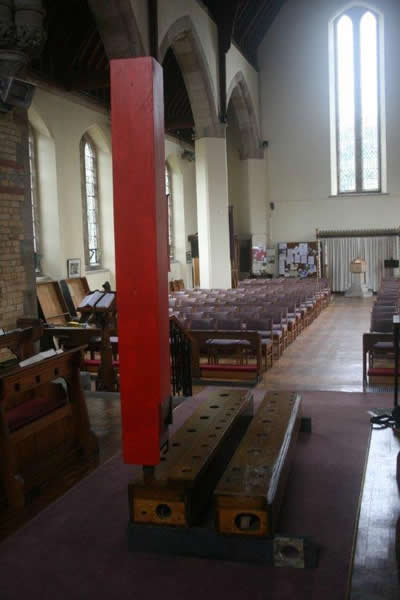 Forty-five years later, this organ was removed to make way for the ‘new’ three manual organ by ourselves. We say new, and it certainly is new to the church, but almost all the pipework is secondhand, as are the reservoirs (bellows), some of the unit chests and the console, although the latter has been extensively rebuilt. The core of the organ is the 1850 Walker organ from St Andrew, Cobham in Surrey, and a significant amount of the 1911 Conacher from Ramsgate Baptist Church. In addition, the previous organ’s pipework has been entirely re-used, as well as ranks by Henry Willis, Gray & Davison, Norman & Beard, Ravensdale and Mander, together with some ranks of uncertain origin.
Forty-five years later, this organ was removed to make way for the ‘new’ three manual organ by ourselves. We say new, and it certainly is new to the church, but almost all the pipework is secondhand, as are the reservoirs (bellows), some of the unit chests and the console, although the latter has been extensively rebuilt. The core of the organ is the 1850 Walker organ from St Andrew, Cobham in Surrey, and a significant amount of the 1911 Conacher from Ramsgate Baptist Church. In addition, the previous organ’s pipework has been entirely re-used, as well as ranks by Henry Willis, Gray & Davison, Norman & Beard, Ravensdale and Mander, together with some ranks of uncertain origin.
There is much new work in the organ, including the electrical system, soundboards and substantial parts of the console. New slider soundboards have been built for the Great, Swell & Choir, and the console has received additional drawstops to encompass the new specification. This has involved redesigning the Compton console to take stop jambs of increased height, as well as the addition of numerous playing aids, ensuring comprehensive control of the instrument by the player. The electrical switching and capture system, including 64 channels of memory and a sequencer has been built by Musicom Ltd, and is both versatile and creative in its use of technology, whilst providing elements, particularly in the control interface, of elegance and ease of use. The connection between the console, which will be moveable, and the organ chamber, is by Cat5 cable, a far cry from the earlier system which used hundreds of individual wires. In addition to the usual couplers and accessories the organ has been fitted with a divided pedalboard, which enables the player to couple different sounds to the top and bottom halves of the pedalboard, and some unusual couplers, including Great to Choir and Swell Reeds on Great, the latter disabling the Swell Reeds from the Swell Manual while coupling them down to the Great Organ simultaneously.
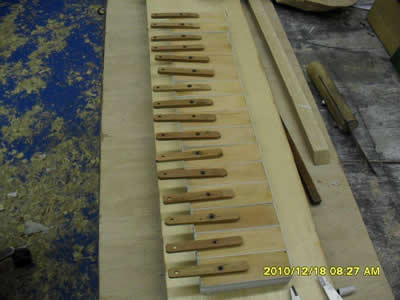 Tonally, the organ is eclectic, relying heavily on the Englishness of the original material, with an essence of the French romantic. At 53 speaking stops, some 55 ranks with little borrowing on the manuals, the organ appears large on paper. At a little under 3,000 pipes the organ is bigger than average, however what is significant is that the specification is designed to be versatile and comprehensive rather than loud (although it will be louder than the old organ!). Variety of tone has been significant in the design, with each department having Principals, Flutes, Strings, and Reeds, and independent Mixtures occurring on two different manual departments and the pedals; in fact the Great has two compound stops, a three-rank Mixture and a four-rank Fourniture. There is a Gamba in each manual department and Violone on the Pedal, creating a useful homogeneity of tone between departments whilst helping with greater versatility; nine separate reed ranks, chorus reeds on the Swell and Pedal, as well as a Trumpet available on both the Great and Choir, and voiced to bridge the gap between a chorus and solo reed; a four foot Chalumeau on the Pedal and an enclosed Voix Humaine in the Swell.
Tonally, the organ is eclectic, relying heavily on the Englishness of the original material, with an essence of the French romantic. At 53 speaking stops, some 55 ranks with little borrowing on the manuals, the organ appears large on paper. At a little under 3,000 pipes the organ is bigger than average, however what is significant is that the specification is designed to be versatile and comprehensive rather than loud (although it will be louder than the old organ!). Variety of tone has been significant in the design, with each department having Principals, Flutes, Strings, and Reeds, and independent Mixtures occurring on two different manual departments and the pedals; in fact the Great has two compound stops, a three-rank Mixture and a four-rank Fourniture. There is a Gamba in each manual department and Violone on the Pedal, creating a useful homogeneity of tone between departments whilst helping with greater versatility; nine separate reed ranks, chorus reeds on the Swell and Pedal, as well as a Trumpet available on both the Great and Choir, and voiced to bridge the gap between a chorus and solo reed; a four foot Chalumeau on the Pedal and an enclosed Voix Humaine in the Swell.
The full specification is given below:
Finally the existing case is being re-used and fully restored. The origins of this case are unknown, with many believing it to be from an earlier house organ, being enlarged and extended when installed in the church. The casework itself is being restored whilst the display pipes are being restored, cleaned and put back on speech after many years. Twenty-two of the display pipes were speaking pipes, with space for two further pipes in the outside towers, while the remaining pipes in the display are wooden dummies. The speaking pipes will be returned to life as the Choir Gamba.
This has been an exciting project for us as organ builders and, as the largest project we have completed to date, a significant challenge. We have embraced the project with enthusiasm, both for its technical opportunities and musical versatility that the organ will display. As a performer, it is an organ that will be capable of realising the vast majority of the organ repertoire with some degree of authenticity.
Jonathan Lane & Associates Ltd can be contacted view their website: www.organ-builder.co.uk
Jonathan Lane is Managing Director of Jonathan Lane & Associates Ltd. He trained first as a communications engineer and subsequently as a musician. Having spent twenty-five years working as a professional music teacher, organist and choir trainer in a number of churches and at Londonderry Cathedral, he started Jonathan Lane & Associates in 2005, becoming a limited company in 2010. The company has two staff at present, Jonathan and a Budapest trained organ builder, Ferenc Dobos, and has a growing reputation and cliental in the South and Midlands.







